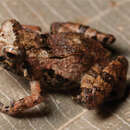en
names in breadcrumbs


Frogs of the genus Platymantis have two geographic centers of diversity and endemism. One large group of species occurs in the Solomon Islands and nearby Bismarck and Admiralty archipelagos (26 species). Another large group of species occurs in the Philippines (29 species). Outside of these two large archipelagos, one species occurs in Palau, seven or eight are known from New Guinea faunal region, two to four species occur in eastern Indonesia, and two species occur in Fiji (for review, see Siler et al., 2010). All species have direct development as the mode of reproduction, with direct-developing egg masses deposited in forest habitat on leaves, moss, twigs, and branches, as well as within leaf litter, and in rocky crevices in limestone outcrops.
Within the Philippines, three species groups are recognized on the basis of external morphology (W. C. Brown et al., 1997a,b; Alcala and W. C. Brown, 1999): the Platymantis dorsalis Group, the P. hazelae Group, and the P. guentheri Group. In addition to the morphological variation among Platymantis in the Philippines, the advertisement calls and preferred microhabitats of the species also vary (R. M. Brown et al., 2002; R. M. Brown and Gonzales, 2007). Surveys have shown that the highly distinctive limestone-forest habitats of the Philippines possess a great diversity of Platymantis and many endemic species (W. C. Brown and Alcala, 1982; R. M. Brown and Alcala, 2000; Siler et al., 2007, 2010).
The Platymantis hazelae Group, as currently recognized, consists of eight species endemic to the Philippines: P. hazelae, P. isarog, P. lawtoni, P. montanus, P. panayensis, P. polilloensis, P. sierramadrensis, and P. subterrestris. Members of this species group have been traditionally diagnosed on the basis of the following combination of characters: 1) terminal phalanx a wide "T"; 2) disks of fingers, except first, broadly dilated; 3) first finger much shorter than second, not reaching beyond midpoint between subarticular tubercle and disk; 4) digits proximal to disks much broader than deep, the result of wide dermal flanges; 5) subarticular tubercles large, round, and only moderately protruding; and 6) toe disks smaller than finger disks (Character and character states for the P. hazelae Group taken from Brown et al., 1997).
The Platymantis guentheri Group, as currently recognized, consists of ten species endemic to the Philippines: P. banahao, P. bayani, P. biak, P. cornutus, P. diesmosi, P. guentheri, P. insulatus, P. luzonensis, P. negrosensis, and P. rabori. Members of this species group have been traditionally diagnosed on the basis of the following combination of characters: 1) terminal phalanx a moderate to wide "T"; 2) disks of fingers, except first, moderately to broadly dilated; 3) first finger shorter than second, reaching as far as base of disk for some species; 4) digits proximal to disks about as deep as broad, the result of narrow, dermal flanges; 5) subarticular tubercles large and strongly protruding; and 6) toe disks about as broad to half as broad as finger disks (Character and character states for the P. guentheri Group taken from Brown et al., 1997).
The Platymantis dorsalis Group, as currently recognized, consists of twelve species endemic to the Philippines: P. cagayensis, P. corrugatus, P. dorsalis, P. indreprensus, P. levigatus, P. mimulus, P. naomiae, P. paengi, P. pseudodorsalis, P. pygmaeus, P. spelaeus, and P. taylori. Members of this species group have been traditionally diagnosed on the basis of the following combination of characters: 1) terminal phalanx bluntly rounded to pointed; 2) tips of fingers blunt, without disks, or with small to moderate disks; 3) first finger slightly shorter, about as long as, or longer than second; 4) digits proximal to disks about as deep as broad; 5) subarticular tubercles large, strongly protruding and frequently pointed; and 6) finger disks smaller than to slightly larger than toe disks (Character and character states for the P. dorsalis Group taken from Brown et al., 1997).
The currently recognized species diversity for the genus, especially within the Philippines, is likely underestimated. Future fine-scale studies of inter-population diversity, as well as studies incorporating genetic data will likely result in the discovery of numerous new, undescribed species. Although the three species groups recognized in the Philippines have long been a useful tool for diagnosing species based on external morphology, it is quite possible that these species groups are not monophyletic, and future studies may reveal phylogenetic patterns inconsistent with our current understanding of species diversity within the genus Platymantis.
This species, as currently recognized, has a disjunct distribution, and has been documented in northern Luzon Island (northern Philippines) as well as Sibuyan Island (central Philippines).
Luzon and Visayan (central) Pleistocene Aggregate Island Complexes (PAIC; Brown and Diesmos, 2002).
This species prefers leaf litter microhabitats on the forest floor in disturbed, and secondary- and primary-growth forest. Individuals are often observed beneath the top layer of leaves and debris in leaf litter habitat.
All species have direct development as the mode of reproduction, with direct-developing egg masses deposited by females in forest habitat.
Municipality of Palanan, Isabela Province, Sierra Madre Mountain Range, eastern Luzon Island, Philippines; type stored in the Philippine National Museum: PNM 6255
The pygmy forest frog (Platymantis pygmaeus) is a species of frog in the family Ceratobatrachidae. It is endemic to the Philippines. It occurs in the Central Cordilleras and Sierra Madres of northern Luzon, and possibly also on Sibuyan Island.
Its natural habitats are subtropical or tropical dry forest, subtropical or tropical moist lowland forest, and subtropical or tropical moist montane forest. It is threatened by habitat loss.
The pygmy forest frog (Platymantis pygmaeus) is a species of frog in the family Ceratobatrachidae. It is endemic to the Philippines. It occurs in the Central Cordilleras and Sierra Madres of northern Luzon, and possibly also on Sibuyan Island.
Its natural habitats are subtropical or tropical dry forest, subtropical or tropical moist lowland forest, and subtropical or tropical moist montane forest. It is threatened by habitat loss.